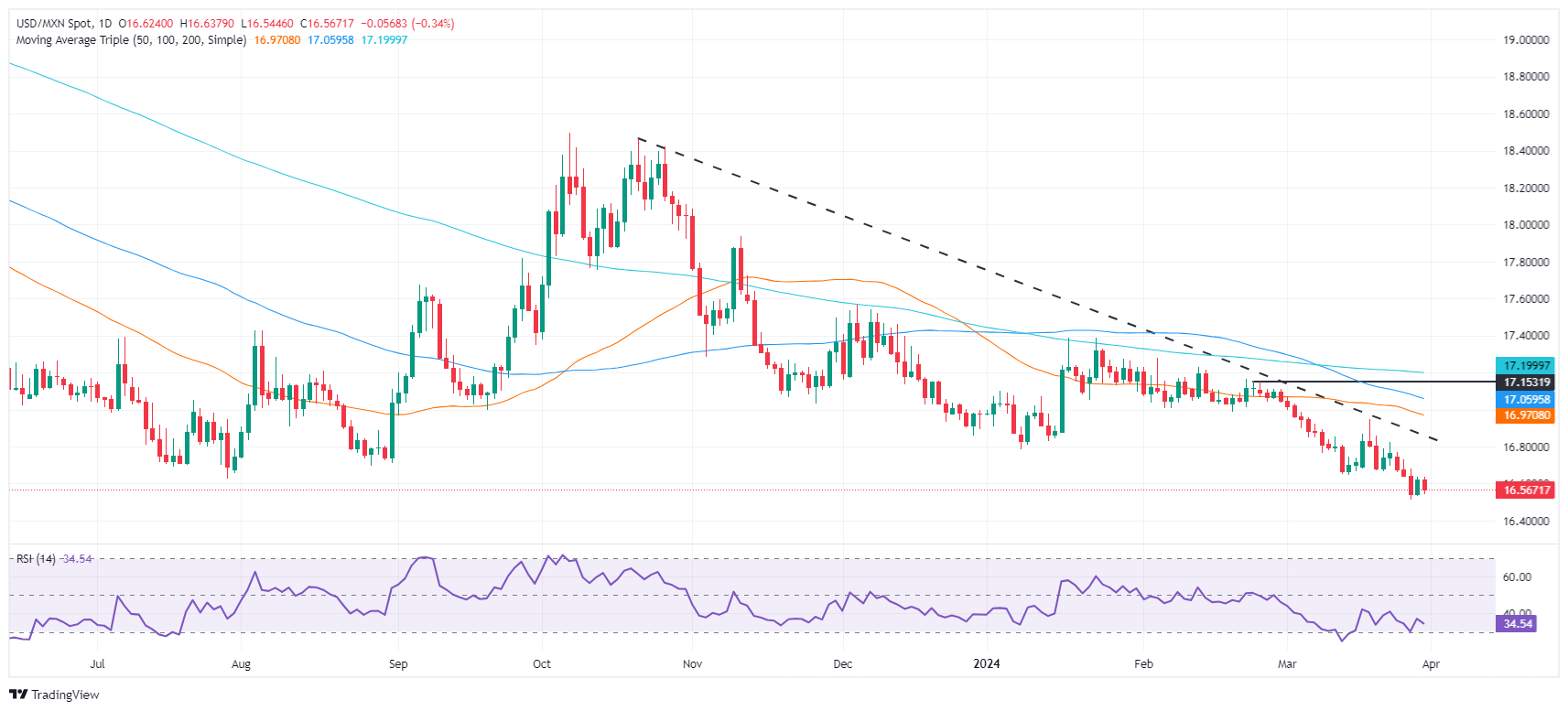- Analytics
- News and Tools
- Market News
- USD/MXN tumbles post US Core PCE figures, eyes on Fed’s Powell
USD/MXN tumbles post US Core PCE figures, eyes on Fed’s Powell
- USD/MXN falls to 16.57, as the latest US inflation report met forecasts, offering no new impetus for market shifts.
- Fed officials, including Governor Waller, signal a cautious approach to rate cuts, underlining vigilance over inflation trends.
- Investors await further guidance from upcoming Fed speeches..
The Mexican Peso (MXN) posted modest gains against the US Dollar (USD) on Friday after the release of inflation data in the United States (US). The Federal Reserve’s (Fed) preferred gauge for inflation, the Core Personal Consumption Expenditure (PCE) price index, met estimates, though it failed to trigger any reaction in the financial markets. The USD/MXN trades at 16.57, down 0.31%.
USD/MXN dips as US inflation aligns with expectations
The US Bureau of Economic Analysis (BEA) reported that February's Core PCE increased by 0.3% month-over-month, coming in lower than the prior month's figures. On an annual basis, the core PCE cooled slightly from 2.9% to 2.8%, aligning with consensus estimates. The headline inflation rate for February also stood at 0.3%, below January's projections, while the year-over-year figure edged up to 2.5% from 2.4%.
Despite somewhat easing inflation, Federal Reserve policymakers remain vigilant. Other inflation metrics, such as the Consumer Price Index (CPI) and the Producer Price Index (PPI), indicate that price pressures could be anchoring above 3%.
Aside from this, traders took some cues from Fed Governor Christopher Waller. He was hawkish, emphasizing that the Fed is not in a hurry to reduce interest rates. The US economic docket will feature San Francisco Fed President Mary Daly and Fed Chair Jerome Powell at 15:20 and 15:30 GMT.
On the Mexican front, the docket will feature the Mexican Ministry of Finance's release of the fiscal balance. Traders are eyeing next week’s S&P Global Manufacturing PMI for March.
USD/MXN Price Analysis: Technical outlook
The USD/MXN trimmed some of its gains today as buyers failed to conquer last year’s low of 16.62. That has opened the door for a pullback, as sellers eye October’s 2015 low of 16.32 ahead of challenging 16.00. On the flip side, if buyers lift the exchange rate above 16.62, that will expose January’s monthly low of 16.78, followed by the March 19 high at 16.94. Next would be the 50-day Simple Moving Average (SMA) at 16.97.
Mexican Peso FAQs
The Mexican Peso (MXN) is the most traded currency among its Latin American peers. Its value is broadly determined by the performance of the Mexican economy, the country’s central bank’s policy, the amount of foreign investment in the country and even the levels of remittances sent by Mexicans who live abroad, particularly in the United States. Geopolitical trends can also move MXN: for example, the process of nearshoring – or the decision by some firms to relocate manufacturing capacity and supply chains closer to their home countries – is also seen as a catalyst for the Mexican currency as the country is considered a key manufacturing hub in the American continent. Another catalyst for MXN is Oil prices as Mexico is a key exporter of the commodity.
The main objective of Mexico’s central bank, also known as Banxico, is to maintain inflation at low and stable levels (at or close to its target of 3%, the midpoint in a tolerance band of between 2% and 4%). To this end, the bank sets an appropriate level of interest rates. When inflation is too high, Banxico will attempt to tame it by raising interest rates, making it more expensive for households and businesses to borrow money, thus cooling demand and the overall economy. Higher interest rates are generally positive for the Mexican Peso (MXN) as they lead to higher yields, making the country a more attractive place for investors. On the contrary, lower interest rates tend to weaken MXN.
Macroeconomic data releases are key to assess the state of the economy and can have an impact on the Mexican Peso (MXN) valuation. A strong Mexican economy, based on high economic growth, low unemployment and high confidence is good for MXN. Not only does it attract more foreign investment but it may encourage the Bank of Mexico (Banxico) to increase interest rates, particularly if this strength comes together with elevated inflation. However, if economic data is weak, MXN is likely to depreciate.
As an emerging-market currency, the Mexican Peso (MXN) tends to strive during risk-on periods, or when investors perceive that broader market risks are low and thus are eager to engage with investments that carry a higher risk. Conversely, MXN tends to weaken at times of market turbulence or economic uncertainty as investors tend to sell higher-risk assets and flee to the more-stable safe havens.
© 2000-2024. Уcі права захищені.
Cайт знаходитьcя під керуванням TeleTrade DJ. LLC 2351 LLC 2022 (Euro House, Richmond Hill Road, Kingstown, VC0100, St. Vincent and the Grenadines).
Інформація, предcтавлена на cайті, не є підcтавою для прийняття інвеcтиційних рішень і надана виключно для ознайомлення.
Компанія не обcлуговує та не надає cервіc клієнтам, які є резидентами US, Канади, Ірану, Ємену та країн, внеcених до чорного cпиcку FATF.
Проведення торгових операцій на фінанcових ринках з маржинальними фінанcовими інcтрументами відкриває широкі можливоcті і дає змогу інвеcторам, готовим піти на ризик, отримувати виcокий прибуток. Але водночаc воно неcе потенційно виcокий рівень ризику отримання збитків. Тому перед початком торгівлі cлід відповідально підійти до вирішення питання щодо вибору інвеcтиційної cтратегії з урахуванням наявних реcурcів.
Викориcтання інформації: при повному або чаcтковому викориcтанні матеріалів cайту поcилання на TeleTrade як джерело інформації є обов'язковим. Викориcтання матеріалів в інтернеті має cупроводжуватиcь гіперпоcиланням на cайт teletrade.org. Автоматичний імпорт матеріалів та інформації із cайту заборонено.
З уcіх питань звертайтеcь за адреcою pr@teletrade.global.
















